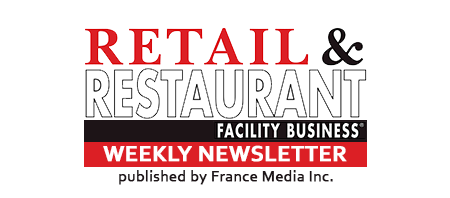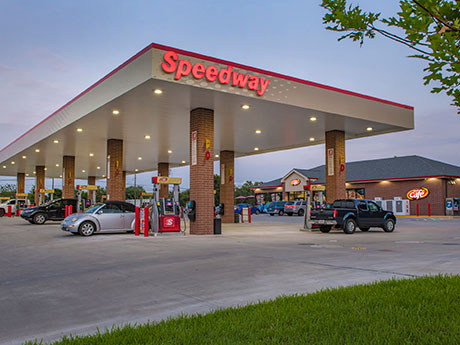8/12: At Home Posts 42% Sales Growth, Eyes Store Expansions
|
|
|
|
 |
|
August 12, 2020 • Issue 234 |
|
|
|
|
Urban Outfitters to Build $350 Million Distribution Center Near Kansas City
|
 |
Kansas City, Kan. — Urban Outfitters plans to develop a $350 million omnichannel distribution center near Kansas City. The 880,000-square-foot development will be located on ancillary land owned by the Kansas Speedway in Wyandotte County, roughly 15 miles outside downtown Kansas City. The Philadelphia-based retailer is set to begin construction on the facility this fall with completion scheduled for early 2022. Read more.
|
Little Caesars Continues Global Growth with First Restaurants in Colombia
|
 |
Detroit — Little Caesars Pizza, one of the largest pizza chains in the world, is continuing its international expansion with its first restaurants in Colombia. The global brand will open two stores in Bogotá this month. Read more. |
Video: One-on-One with Bill Schaphorst of MaintenX International |
 |
Pictured left to right are Randall Shearin, Senior Vice President of France Media, and Bill Schaphorst, Vice President of Business Development at MaintenX International.
Bill Schaphorst, vice president of business development at MaintenX International, spoke to Retail & Restaurant Facility Business last week about how facility managers are coping and adding value for their clients in the midst of an ongoing evolution in customers' approaches to retail and restaurants. Listen to this brief but informative interview on how MaintenX has implemented safety guidelines, updated procedures, worked with facility managers and attempted to add more value for clients in the midst of a shifting environment.
Listen to this complimentary webinar by registering here. |
|
|
|
|
Have you read the July issue? |
Cover Story: Great Food Fuels Growth
How Slim Chickens is not only surviving — but thriving — during COVID-19.
Shifting Priorities
HVAC systems are no longer an afterthought post COVID-19 lockdown.
Optimize Performance & Costs
Proper water heater selection impacts your restaurant's bottom line.
Before the Snow
Snow season will sneak up on you! Now is the time to prepare.
Detecting Hotspots
As the foodservice industry changes, fire protection technology offers smarter, more scalable solutions with electric detection for complex cooking environments.
|
|
|
|
|
|
|
At Home Posts 42% Sales Growth in Second Quarter, Eyes Store Expansions
|
Plano, Texas — At Home, a home décor and furnishings retailer, posted net sales of $515 million in its fiscal second quarter, which ended July 25, and is reportedly looking to expand its footprint. That figure represents a 42% year-over-year increase in comparable store sales. Read more.
|
Steak n Shake to Sell 15 Company-Owned Locations
|
 |
New York City — Steak n Shake Inc. is bringing to market 15 restaurants the company closed during the last 12 months. Keen-Summit Capital Partners LLC and NAI Global have been retained to run a sale process of the portfolio. Read more.
|
Marathon Petroleum to Sell Speedway to 7-Eleven for $21 Billion
|
 |
Findlay, Ohio — Marathon Petroleum Corp. has entered into a definitive agreement with 7-Eleven Inc., whereby 7-Eleven will acquire the convenience store chain Speedway for $21 billion in cash. Read more.
|
|
|
Smokey Bones Opening 122 New Virtual Restaurants
|
 |
Aventura, Fla. — Not many restaurants can triple in size during a global pandemic, but Smokey Bones is doing just that by expanding its virtual restaurants, The Wing Experience and The Burger Experience, to all of its brick-and-mortar restaurants.
Read more.
|
The Home Depot Plans to Open 3 Distribution Centers in Atlanta Area
|
 |
Atlanta — The Home Depot® will open three new distribution centers in Georgia over the next 18 months to support the growing demand for flexible delivery and pickup options for professional and do-it-yourself (DIY) customers. The expansion is projected to bring approximately 1,000 additional jobs to the Atlanta area. Read more.
|
Dickey's Food Truck Model Thrives Amid the Pandemic
|
 |
Dallas — Dickey’s Barbecue Pit is rapidly expanding its non-traditional store count with the development of seven new food trucks units. The 79-year-old barbecue franchise reports an uptick in interest from both new and existing franchisees in its food truck model as the COVID-19 pandemic continues to make an impact on restaurant dining rooms. Read more.
|
|
|
Top Story |
Beware the Pandemic Profiteer
|
 |
— By Thomas Holland, APEX Surface Care —
When you need disinfection and you need it fast, you have to be careful.
As restaurants, retailers and other businesses reopen across the country, they are doing everything in their power to help keep employees and customers safe. Despite all their planning and preparation, however, when COVID-19 arrives on the scene, the initial reaction is often a frantic phone call to the first company that comes to mind, usually a local janitorial or restoration company.
Unfortunately, some unscrupulous providers are gouging clients in their time of need. One company, desperate for a quick disinfection after an active case of COVID, paid a national restoration company $12,000 to disinfect its 25,000-square-foot building. The facility manager’s relief quickly turned to dismay when he learned that he should have paid closer to $2,000. He was charged six times more than he should’ve been. Generally speaking, the cost of disinfecting should be similar to what you pay for carpet cleaning.
Pricing isn’t the only issue. Many of these new “disinfection experts” never touched an electrostatic sprayer or applied any real quantity of disinfectant before the pandemic began. Inexperienced companies may not be using the right equipment or the right product, and even when they do have the proper tools, they may not be using them correctly. Facility managers looking to find an experienced service provider should ask a few key questions:
What Equipment Do They Use? Electrostatic spraying is the most efficient and effective way to apply a disinfectant. This method evenly coats surfaces, including hard-to-reach areas or irregularly shaped objects like chairs or items on a table. Regular spraying or fogging only covers what the sprayer is pointing at while electrostatic spraying “wraps” the spray around objects. In addition, electrostatic spraying is safer than other methods. Ultra-low volume foggers, for example, aerosolize the disinfectant, making it airborne and potentially causing respiratory distress in users without proper personal protective equipment. Due to high demand, professional-grade equipment currently is in short supply, causing many inexperienced providers to use equipment purchased at the local hardware store.
What Product Do They Use? More important than the application method used is the product used. When fighting the coronavirus, providers should only use a product on the EPA’s List N: Disinfectants for Use Against SARS-CoV-2. But just because a product is on List N doesn’t make it safe. In addition, many disinfectants have extremely high or extremely low pH levels, making them harmful to surfaces in the long term. Disinfectants are regulated as pesticides and should be treated as such. The safest disinfectants have a Hazardous Materials Identification System (HMIS) rating of 0.0.0.0, have a near-neutral pH level, and are NSF-certified as food-grade safe.
What Experience Do They Have? A tool is only as good as its user. It’s important to qualify your provider to make sure its technicians have the necessary experience and expertise. Lack of training can result in inconsistent coverage and damaged surfaces or equipment. Look for providers who are trained and certified in infection prevention through the Academy of Cleaning Excellence (ACE), the Global Biorisk Advisory Council (GBAC) or a similar organization.
For safety and performance reasons, disinfecting is best left to trained professionals. However, that doesn’t mean it can’t be cost-efficient. Ultimately, you want to look for qualified companies that are more interested in building a long term relationship with you than in getting rich quick.
— Thomas Holland is the CEO of APEX Surface Care, a 23-year-old Certified B Corporation® and national specialty surface care company headquartered in Texas. APEX has provided infection control services for over a decade and across tens of millions of square feet. For more information, visit www.goapex.com.
|
Vendor News |
Supply Chain Leader Imperial Dade Opens New Facility
|
 |
Franklin, Mass. — Imperial Dade, a leading national distributor of foodservice packaging and janitorial supplies, has opened a new warehouse facility in Franklin, Mass. The more than 300,000-square-foot warehouse offers direct access to the greater New England area. The facility is the 34th location for Imperial Dade and will support the company’s expanding customer base and continued growth in the Northeast.
Read more.
|
Connex Resource Committee Names Telgian's Steve Goyette Supplier Co-Chair
|
 |
Phoenix — Steve Goyette, vice president of business development for Telgian Fire Safety, was recently named supplier co-chair of the Connex Resource Committee. Maile Keliikuli, retail facilities manager at REI, will hold the position of retail co-chair.
Read more.
|
Coronavirus News |
For COVID-19 related news affecting the retail and restaurant industry, please click here.
Coverage is updated daily. |
|
|
Upcoming Events |
| Connex2021 Multi-Site Facilities Conference April 19-21, 2021 • National Harbor, MD
The NAFEM Show 2021 August 26-28, 2021 • Orlando |
More Industry News |
|
|
| Forward Newsletter to a Friend |
|
From the Magazine |
Optimize Performance & Costs
By Paul Bothner
|
Proper water heater selection impacts your restaurant's bottom line.
As the restaurant industry reopens its doors after the national shutdown, owners are even more focused on improving operating profits. One area of evaluation needs to be the generation of hot water, as it is among the largest — and, in some cases, the Number 1 — energy consumer of all installed appliances within hospitality facilities, particularly restaurants.
For this reason, higher efficiency, condensing water heater designs comprise the majority of installations on new construction projects, as well as current retrofits. This trend is expected to continue due to the rapid payback of the technology compared to older less efficient units.
Restaurant owners need to select a water heater based on more than “banner specs” such as efficiency rating, however. Three other factors to evaluate are footprint, materials of construction, and controls to get the best return on investment (ROI) and lower operating costs.
Smaller Footprint = Bigger Revenue Perhaps the biggest trend is the need for larger BTUs in a smaller water heater. Restaurant owners are looking for units that deliver the necessary capacity in a more compact footprint. By minimizing the space occupied by the water heater, more square footage can be dedicated to revenue-generating operations. Adding an extra table or two can bring in additional dollars.
While some may consider wall-hung units as an alternative, they could actually prove to be less efficient. There are now water heaters that are so compact that they occupy less space than wall-hung units. These ultra-compact water heaters also have zero-side clearance capability to create a redundant system in the same space of a single tank water heater.
Another hidden cost factor associated with wall-hung units is their propensity for temperature fluctuations. To offset this variable, water tube instantaneous heaters are often installed with a storage tank in high-demand commercial applications, such as larger restaurants. Additional space is, therefore, required.
There is another cost associated with such a system. The “instantaneous” nature of the product vanishes, as the operation changes from responding to variations in flow and adjusting burner firing rate accordingly to simply reheating the tank at high fire as quickly as possible between demands. This configuration lowers the efficiency of a water tube product due to its limited ability to modulate and the ever-increasing entering water temperature as the tank returns to set point. The result is increased operating expenses. Read the full article. |
|
|
From the Magazine
|
Shifting Priorities
By Elizabeth Ortlieb
|
HVAC systems are no longer an afterthought post COVID-19 lockdown.
Discussions on HVAC systems and maintenance best practices have become prominent amid the COVID-19 pandemic. With this development comes the recognition that HVAC in commercial buildings can no longer be an afterthought post COVID-19 lockdown, particularly as it relates to adhering to maintenance best practices and enhancing maintenance programs.
Business owners, facility managers and maintenance personnel need to be aware and know the implications of the new recommended HVAC controls for COVID-19 mitigation.
While there are other control methods, such as social distancing and increasing disinfection of frequently touched surfaces, that take more importance in ensuring a safe indoor environment HVAC control methods have undoubtedly become a focal point amongst stakeholders.
The Role of HVAC in COVID-19 Mitigation Efforts Amidst the height of the COVID-19 pandemic, numerous stakeholders were debating the role HVAC systems play in virus transmission. In fact, speculations and rumors soared. As an example, at one point, some were asking if air-conditioning systems should be turned off.
As a result, the American Society of Heating, Refrigerating and Air-Conditioning Engineers (ASHRAE) published two official statements: (1) a statement on airborne transmission of SARS-CoV-2/COVID-19, and (2) a statement on the operation of HVAC systems to reduce virus transmission. The former statement deems airborne transmission of COVID-19 “sufficiently likely” and that HVAC operational changes can reduce airborne exposures.
Both statements, along with crucial information on building reopening and operational best practices, can be found on ASHRAE’s COVID-19 Preparedness Resources website: http://www.ashrae.org/covid19.
Recommended HVAC Management in Commercial Buildings The HVAC management strategies that are being looked at pertain to filtration and ventilation as well as temperature and humidity control. Read the full article. |
|
|
 |
| View the Vendor Directory |
|
|
|
|
|
|
|
|
|
|